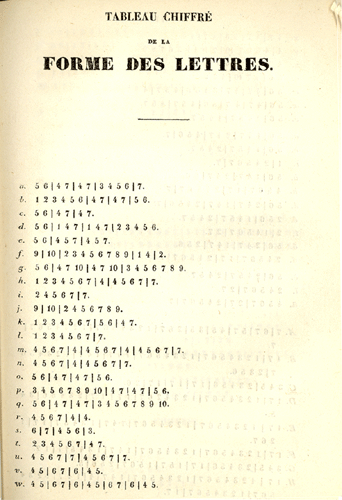Page from Louis Braille's book Nouveau procede pour representer des points la forme meme des letters, les cartes de geographie, les figures de geometrie, les caracteres de musiques, etc., a l'usage des aveugles [New Procedure for representing by means of dots the precise shape of letters, geographical maps, geometrical shapes, musical notes, etc., for use by the blind]. The book explains his system whereby people who are blind can write letters that can be read by sighted people. This page lists the letters a-w and their number matrix equivalent. 1839.
Louis' genius did not end with the six-dot braille system. By the late 1830s, he was working on a method whereby people who were blind could communicate efficiently and swiftly with sighted people. The system was called decapoint.
Decapoint utilized a set of 100 dots on a 10 by 10 grid. Each letter was based on a dot configuration that could be looked up on a table Louis developed.
The illustration at left shows the letters "a-w" and their numeric dot-matrix equivalent. The dots in the decapoint alphabet replicate the shapes of letters; all letters have a minimum height of 4 dots, those letters that have longer stems such as p or d are accommodated by 3 dots either vertically above or below the 4 main dots. Using a board with heavy paper on it and a stylus, the user could trace the dot patterns to represent letters. The person writing went from right to left. After he or she finished, the writer would turn the paper over and read from left to right. The letters could be felt or seen with the eyes.
Louis' next task was to invent a machine that could tap out the dot formations. He sought assistance from Pierre-François-Victor Foucault, a mechanic and former pupil of the Institute, to invent a machine to write decapoint without having to use a stylus to create every dot. The result was a machine called a raphigraphe (needle-writer). Foucault's machine was recognized with a platinum medal in 1843 by the Society for the Encouragement of National Industry.
